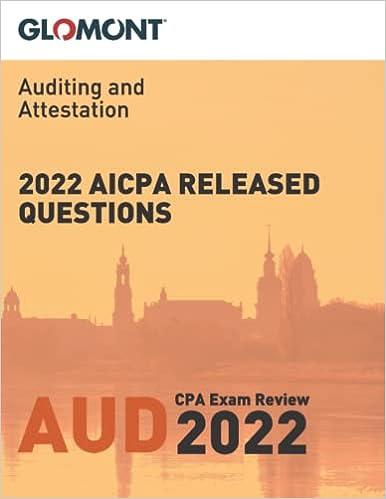Answered step by step
Verified Expert Solution
Question
1 Approved Answer
1. Management accounting primarily is concerned with providing: a) Information to managers inside the organization as well as information to shareholders, accounts payables, and others
1. Management accounting primarily is concerned with providing:
a) Information to managers inside the organization as well as information to shareholders, accounts payables, and others outside the organization.
b) Information to shareholders, accounts payables, and others outside the organization.
c) Information to managers inside the organization.
d) Information to governmental regulatory agencies.
2. A performance report typically compares budgeted data to actual data.
a) True
b) False
3. In decision making, managers use:
a) Financial accounting information exclusively since it is more objective and precise due to well-established principles and conventions.
b) Information regarding the organization as a whole rather than segments of the organization in order to capture a broader perspective of the company's operations.
c) Information that is as precise as humanly possible.
d) Whatever information is relevant to the decision even though the information may not conform to generally accepted accounting principles.
4. Responsibility accounting aims to:
a) Ensure that a manager is punished if things go wrong
b) Reduce the costs that a department incurs
c) Allocate costs to all areas of a business
d) Ensure that costs become the responsibility of a specific manager
5. A cost centre is:
a) The part of the business where all costs are paid to suppliers
b) A production department where all production costs are aggregated
c) An area of the business accountable for both costs and revenues
d) An area for which costs are accumulated
6. Which of the following is not a function of budgeting?
a) Planning
b) Controlling
c) Decision making
d) Motivating
7. If actual output is lower than budgeted output, which of the following costs would you expect to be lower than the original budget?
a) Total variable costs
b) Variable costs per unit
c) Total fixed costs
d) Fixed costs per unit
8. Examine the following data:
Material A
Standard price per kg
5.00
Standard usage per unit
7 kg
Actual price per kg
4.50
Actual usage per unit
8kg
The material price variance would be:
a) 4.00 adverse
b) 3.50 adverse
c) 4.00 favourable
d) 3.50 favourable
9. The correct formula for the labour efficiency variance is:
a) Standard wage rate less actual wage rate multiplied by standard hours
b) Standard wage rate less actual wage rate multiple by actual hours
c) Standard hours less actual hours multiplied by standard wage
d) None of the above
10. A favourable labour variance combines with an adverse wage rate variance could be caused by:
a) Higher unemployment in local economy
b) Cheaper raw materials imported due to exchange rate depreciation
c) Introduction of performance related pay
d) Cost cutting exercises implemented by management
11. Which of the following statements is true about activity based costing systems (ABC)?
a) ABC systems cost less to run than absorption costing ones
b) ABC costs are not as good for making decisions as absorption costs
c) ABC costs are more accurate than absorption ones
d) Absorption costing is a more complex system than ABC
13. If, instead of ABC, Ernie Ltd used an absorption costing system based on a single machine hour overhead absorption rate, the production cost of one square metre of shelving would be:
a) 5.15
b) 3.28
c) 4.64
d) 5.48
14. Which of the following costs is relevant in decision-making?
a) Committed costs
b) Cash costs
c) Accounting costs
d) Historical costs
15. An opportunity cost is the cost of
a) Lost business
b) Unplanned new business
c) The next best alternative course of action
d) Obtaining new business opportunities
16. To complete an order for making curtains, Rosie will need to employ three seamstresses for two days at 30 per day. It will also take 5 hours of her time, which she costs out at 10 per hour. She will receive 500 and have to buy materials of 220. If she accepts this order, she will have to turn down another order, which would have generated a contribution of 80. How much contribution will she make?
a) 100
b) 20
c) None
d) 50
17. The first step in formulating a linear programming problem is
a) Graph the problem
b) Perform a sensitivity analysis
c) Identify the objective and the constraints
d) Define the decision variables
e) Understand the managerial problem being faced
18. In order for a linear programming problem to have a unique solution, the solution must exist:
a) At the intersection of the non-negativity constraints
b) At the intersection of a non-negativity constraint and a resource constraint
c) At the intersection of the objective function and a constraint
d) At the intersection of two or more constraints
e) None of the above
19. A learning curve describes
a) The increase in number of units produced per unit time as the total number of units produced increases
b) The rate at which an organisation acquires new information
c) The increase in production time as the total number of units produced increases
d) The amount of production time per unit as the total number of units produced increases
20. When calculating expected values we are:
a) looking at the most likely result that is going to occur
b) looking at the average result likely to occur
c) looking at the best result that can be expected
d) looking at the worst result that can be expected
Step by Step Solution
There are 3 Steps involved in it
Step: 1

Get Instant Access to Expert-Tailored Solutions
See step-by-step solutions with expert insights and AI powered tools for academic success
Step: 2

Step: 3

Ace Your Homework with AI
Get the answers you need in no time with our AI-driven, step-by-step assistance
Get Started


